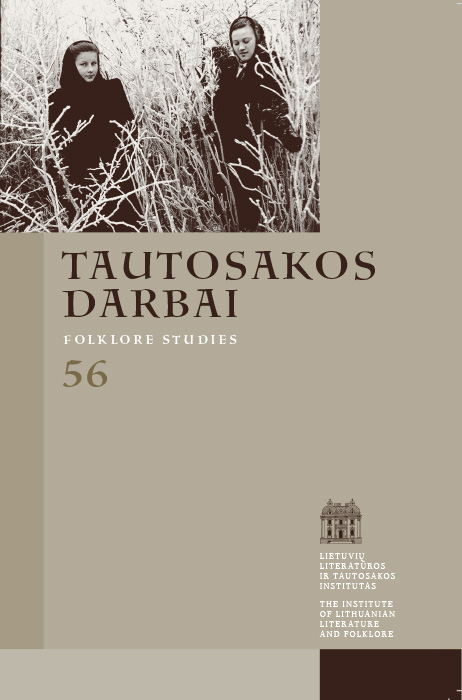The Karaim Space of Trakai in the Local Lore and the Legend of the Miraculous Horse of the Duke Vytautas
Abstract
Several dozens of Karaims still residing in Trakai may be regarded as the true inhabitants of the town, considering that at least several generations of them lived there. While analyzing their life stories collected during fieldwork in 2008–2018, and comparing them to the testimonies of other Trakai dwellers describing Karaims, it becomes clear that Karaims have a number of definite places making up their “own” space and a meaningful topography. This typography comprises the northern part of the Trakai Peninsula, the northwestern suburban territories and the nearby lakes. In the oral tradition, part of the Trakai Peninsula attributed to Karaims bears the name Karaimščizna or Karaimų gatvė (‘Karaim Street’). It runs from the Chapel of St. John of Nepomuk to the so-called Iron Bridge in the neck between Galvė Lake and Totoriškės Lake. Not only Karaims, but also other ethnic groups residing in Trakai define this area as special in linguistic, religious, social, economic, and urban sense. From the social perspective, Karaims enjoy certain double status: being the “original” inhabitants of Trakai, they are also the most singular and the least known ones. Stories by the other ethnic groups abound in descriptions of certain “strangeness” of the Karaims. In the 15th – 18th centuries, Karaims enjoyed certain autonomy in this part of the town. At that period, two towns endowed with the Magdeburg rights co-existed in the small Trakai Peninsula – the Karaim town and the Christian town. Even today, Karaims consider their historical part of the town to be the “real Trakai”. Karaims are outstanding in terms of their particularly strong community bonds, including common religion, ethnic origins, history, and kinship. In general, the sense of community largely defines the special Karaim attitude to Trakai. For them, the town is not just a place of residence, but also a meaningful space in terms of the common historical, celebratory, family and everyday experiences. The common experience is also evident in the famous Karaim legend describing the miraculous horse of the Duke Vytautas. This legend starts with the time of the Karaims settling in Trakai under the rule of Vytautas the Great. After a particularly harsh winter, the spring tide causes the lakes surrounding Trakai to spill over, and the flood threatens to drown the part of the town inhabited by the Karaims. However, the horse of Vytautas gulps down the water, and the next morning a new lake appears in the horse’s pasture, emitting strange smell. Different variants of the legend point to several lakes, but all of them are within area that is meaningful to Karaims, and close to the former communal lands, the so-called Karaim fields. Historians and folklorists investigating this legend so far have mostly concentrated on the image of Vytautas. The author of this article treats this legend as a source presenting the places that Karaims consider important, and their daily routines (their main trade was growing vegetables, particularly cucumbers). This legend also provides evidence of the attempts undertaken by the 20th century Karaim intelligentsia at establishing the modern Karaim identity. The best-known variants of this legend were recorded in the 20th century by Abraomas Šišmanas (Abraham Szyszman) and the senior hazzan Simonas Firkovičius. Both of them paid great interest to the Karaim culture during the interwar period, spreading certain important messages in their folklore recordings as well. These include, for instance, the depiction of Karaims as warriors. This legend merits consideration in terms of space and the Karaim everyday life, particularly in the context of the fieldwork data collected in the 21st century, and observations of the Karaim life style. The legend in question emerges as the verbal testimony of the people coming from the Black Sea region and struggling to adapt in the completely new surroundings, characterized by entirely different climate – long winters and lots of water.
Downloads
Most read articles by the same author(s)
- Lina Leparskienė, Tatars by the Vokė River: Historical Memory and Personal Experiences , Tautosakos darbai: Vol. 63 (2022)
- Rūta Žarskienė, Inga Vidugirytė, Asta Skujytė-Razmienė, Gražina Kadžytė, Lina Leparskienė, Vita Džekčioriūtė-Medeišienė, Dalia Zaikauskienė, Chronicle , Tautosakos darbai: Vol. 58 (2019)
- Guntis Pakalnas, Rimantas Sliužinskas, Asta Skujytė-Razmienė, Radvilė Racėnaitė, Vita Ivanauskaitė-Šeibutienė, Rūta Žarskienė, Lina Leparskienė, Andželika Jakubynienė, Chronicle , Tautosakos darbai: Vol. 47 (2014)
- Lina Leparskienė, “Looking at the World, I Spot Small Details”: the Researcher‘s View on Folklore, Mythology, and Local Culture. A conversation with the National Jonas Basanavičius Prize Winner for 2023 Daiva Vaitkevičienė , Tautosakos darbai: Vol. 67 (2024): Tautosakos darbai
